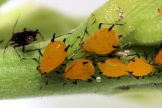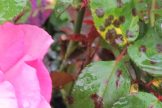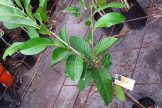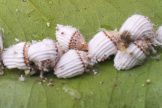
These can explode in numbers seemingly overnight and yesterday’s beautiful healthy foliage can turn into today’s twisted and curled up mess as you can see from the pictures here of our poor esplaiered cherry in Edible Alley (on the left as you enter the driveway). The difficulty with black aphid in this situation is that most sprays rely on getting the spray onto the aphid, and that is almost impossible when the leaves are curled up and the aphids are busy sucking away on the inside. Your best friends are ladybirds, lacewings and parasitic wasps. These will find the aphids within their curled leaves and they are excellent predators. A good supplier of natural predators is http://www.biologicalservices.com.au/.
If you can’t wait for the natural predator numbers to build up and just have to spray, using any of the contact insecticide sprays (pyrethrums, white oils etc) means you must get the spray onto the insect, so you will need to spray the undersurface of the leaves. Not an easy job when the leaves are curled up and this means you will unavoidably kill some of the natural predators.
Traditionally systemic insecticides have been recommended for treating this type of infection. However, recent scientific research has started to question the impacts of such chemicals including potential links between their usage and the occurrence of bee colony collapse. As a precaution Bulleen Art & Garden has removed these chemicals from our shelves as we await for further evidence concerning their safe usage.






